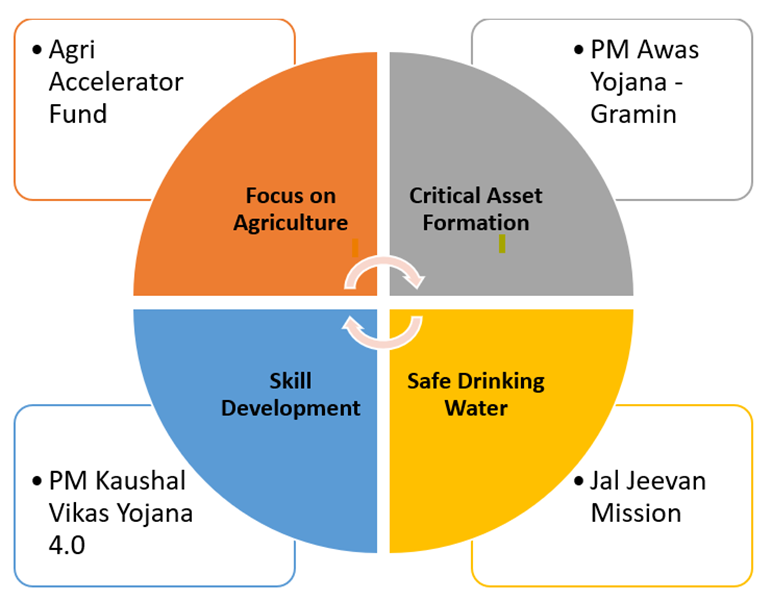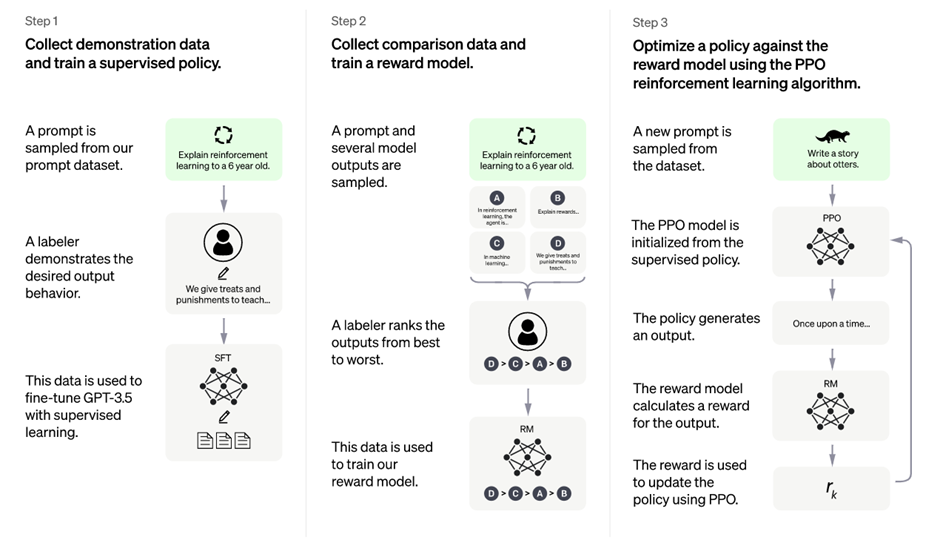Thursday, 9th February 2023
Revamping Rural Area - Edukemy Current Affairs
Exam View: Constitutional Provisions Related to Rural Development in India, Issues with Rural Development in India, Initiatives taken by Government, Sumit Bose Committee’s recommendations, MGNREGS
In News: Rural development needs robust MGNREGS and interconnected schemes to bring about a difference. India is predominantly a rural country with two third population and 70% workforce residing in rural areas. The rural economy constitutes 46% of the national income.
The year 1991 marked a watershed in the country moving up the economic growth path. Likewise, from 2005-06 onwards social development, except for learning outcomes, has improved despite challenges.
In the UNDP Multidimensional Poverty Index, 2022, it is stated that during the last 15 years, rural housing, education, primary health, bank accounts, women's collectives, teleconnection, technology, job creation, skills training, social assistance, and rural roads have contributed to India being able to lift 415 million people out of multidimensional poverty.
Rural areas saw the fastest reduction in Multidimensional Poverty Index. Deprivations in sanitation, cooking fuel, and housing fell the most from 2015-16 to 2019-21. “Despite tremendous gains, the ongoing task of ending poverty for the 228.9 million poor people in 2019-21 is daunting — especially as the number has certainly risen since the data were collected.”
|
Constitutional Provisions Related to Rural Development in India: |
|
Article 40: The state shall take steps to organize village panchayats and endow them with such powers and authority as may be necessary to enable them to function as units of self-government. 73rd Constitutional Amendment Act: build democracy at the grassroots level and was entrusted with the task of rural development in the country. Eleventh Schedule of the Constitution: It places 29 functions within the purview of the Panchayati Raj bodies including agricultural extension, land improvement, implementation of land reforms etc. |
Issues with Rural Development in India:
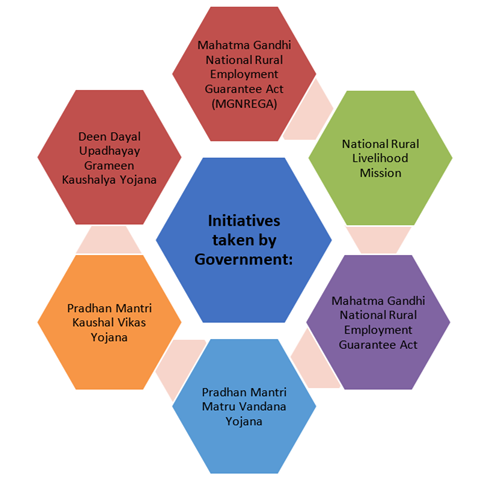
- Low literacy rate
- Inadequate healthcare services
- Lack of Infrastructure
- Poverty
- Higher dependency on the Agriculture Sector
- Loss of natural resources
- Higher Inflation
- Limited Financial Autonomy
- Gender-based discrimination
Steps Required for Rural Development:
Empowering Self-Help Groups: Women in self-help groups offer unprecedented social capital, providing an opportunity for human development, credit access, enterprise, and sustainable poverty reduction through diversified livelihoods.
Providing Skill Sets: To take responsibility for the 29 sectors, local governments will require skill sets that facilitate better governance outcomes at the cutting edge for citizens. The possible pathways could be Community cadres like the ASHA Community Health Worker and the Community Resource Persons of the Livelihood Mission.
The Sumit Bose Committee’s recommendations are the Decentralization of planning and implementation of rural development programs, Strengthening the Panchayati Raj Institutions, focusing on Agricultural and Allied Activities, Improving Rural Infrastructure, etc.
Utilizing MGNREGS: To address rural distress, MGNREGS can be utilized by providing guaranteed employment to rural workers, thereby ensuring a steady source of income. In times of severe distress, MGNREGS can be ramped up to provide additional employment and support to affected communities.
-
- Several studies have established its efficacy in water conservation, basic infrastructure, and income from animal resources through convergence.
Other Initiatives:
-
- In Rajasthan, MGNREGA is being used in selected villages in Rajasthan to address water security issues.
- Maharashtra’s water works.
- Bihar’s Hariyali Mission
- Telangana’s Plant Nursery in every gram panchayat and thrust on afforestation; segregation sheds, soak pits, percolation tanks, sports grounds, crematoriums, rural haats in many States
- Chhattisgarh’s MGNREGS use for Forest Rights Act beneficiaries.
- Sikkim transformed through MGNREGS in spring-shed development to provide drinking water, animal sheds for dairy, and high-value organic farming.
https://www.thehindubusinessline.com/opinion/getting-real-on-rural-uplift/article66478848.ece
Non-tractor farm machinery industry in India
In News:
The National Council of Applied Economic Research’s (NCAER) Report “Making India a Global Power House on Farm Machinery Industry” was released that analyses the non-tractor farm machinery industry from both demand and supply side perspectives, bringing out the challenges in the sector, and recommending measures & reforms by benchmarking global practices in their report.
About the News:
Farm mechanization in India is marked by ‘tractorisation’. India’s farm equipment market is 7% of the global market, with more than 80% of the value contribution coming from tractors. Hence the report focuses on twin objectives for a 15-year vision:
- To recommend to policymakers key strategic actions to be taken to foster the growth of the non-tractor farm machinery industry in India and make it into a global production hub, and
- To improve the match between the needs of Indian farmers and Indian farm machinery producers in terms of price, quality, and efficiency of the machinery.
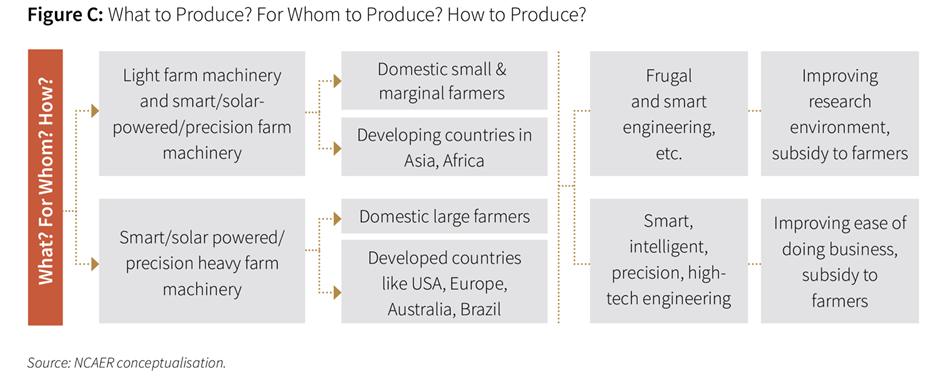
What are some demand-side challenges to farm mechanisation in India?
- Small and fragmented land holdings: In 2018–19 barely 4.4% of farmer households in India owned a tractor and 2.4% a power tiller.
- 85% of farmers in India are small and marginal.
- Lack of access to farm power and credit for equipment.
- Practice of subsistence agriculture.
- Diverse soil conditions and cropping patterns.
- Credit constraints, especially for small and marginal farmers.
- External demand shows lop-sided patterns: Farm machinery exports are driven by the export of tractors, and farm machinery imports are driven by non-tractor farm machinery imports.
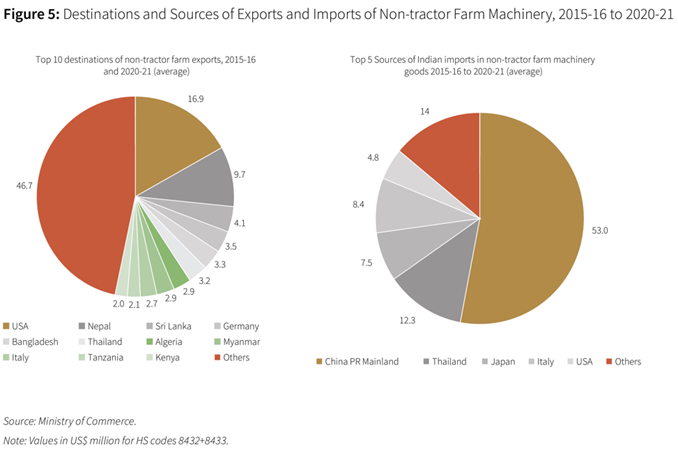
- Dependence on China: 53% of non-tractor farm machinery imports are coming from China, but the export markets are relatively more diversified.
- High costs of equipment.
- Inadequate quantity and quality of service centres for maintenance.
- Machinery rental market is not inclusive of small and marginal farmers in India.
What are some Supply-side Challenges to farm mechanisation in India?
- Ease of doing business and inconsistent regulations make it a challenging environment for the industry.
- Shortage of skilled workers.
- Little sustained collaboration between academia and industry.
- In the academic institutes dedicated to farm mechanisation few of the new innovations are commercialised.
- Micro, small & medium enterprises have no connection with the larger research world.
- Large firms have not been able to translate academic partnerships into a sustained collaboration.
- Competition with China: Chinese imports are sold on Indian DBT portals to Indian farmers at a subsidised rate.
- The farm machinery industry is dominated by Chinese State-owned enterprises.
- The Chinese government sometimes funds the private sector directly and encourages public-private partnerships.
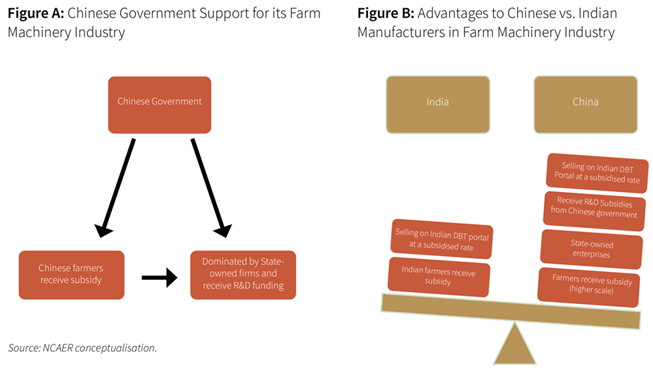
What are some initiatives by the Government of India to promote farm mechanisation?
- Farm mechanisation is part of key schemes:
- Rashtriya Krishi Vikas Yojna (RKVY),
- Mission for Integrated Development of Horticulture,
- National Mission on Oilseeds and Oil Palm and
- National Food Security Mission.
- The Sub-Mission on Agricultural Mechanisation (SMAM) was introduced by the Government in 2014–15.
- Until 2021–22, SMAM was the largest central government stand-alone scheme for farm mechanization.
- It was merged with RKVY in 2022–23.
- States such as Kerala, Madhya Pradesh, and Tamil Nadu are providing farm machinery at a concessional rate, while some other States are providing subsidies via Direct Benefit Transfers,
- Custom Hiring Centres (CHCs) have been set up through a SMAM scheme.
- Subsidy is provided at 40% of the project cost to individual farmers up to a project cost of ₹60 lakh and 80% to a group of farmers up to a project cost of ₹10 lakh.
- For North Eastern Region (NER); 95% subsidy up to a project cost of ₹10 lakh is provided.
- Subsidy of 50–80 per cent for crop residue management machinery.
- Farmer groups are being provided financial assistance at 80 per cent of the project cost to establish Farm Machinery Banks.
- The Kisan Credit Card (KCC) Scheme enables farmers to purchase agricultural inputs.
- An interest subvention scheme provides interest subvention of 2% per annum to banks on the use of their resources. An additional 3% incentive is given to farmers for prompt repayment of the loan.
Source:
https://pib.gov.in/PressReleaseIframePage.aspx?PRID=1897076
Budget slashed for the Ministry of Minority Affairs
In News:
The Budget allocation for the Ministry of Minority Affairs was reduced by 38% for the financial year 2023-24 to the year 2022-23.
About the News:
The Budget estimate for the Ministry of Minority Affairs saw almost 50% cut in the special schemes for minorities.
- Prime Minister-Virasat ka samvardhan (PM Vikas) Scheme was added worth a total of ₹540 crores.
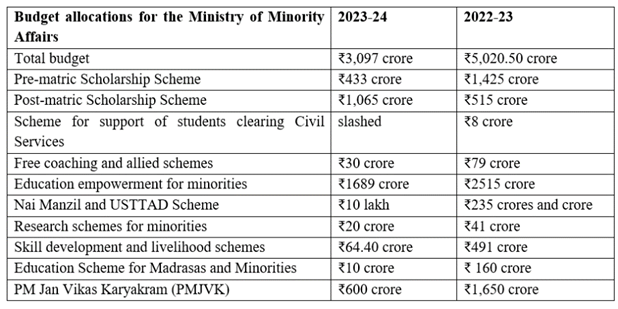
How will the budget cut impact minorities?
- On the basis of Census 2011 data, 870 Minority Concentration Blocks (MCBs), 321 Minority Concentration Towns (MCTs), and 109 Minority Concentration Districts HQs (MCD HQs) falling in 33 States/UTs have been identified.
The decline in funding will impact this population:
- It will affect the functioning of madrasas, school education, and higher research.
- It will impact the local development in areas of minority concentration.
- It will impact their socioeconomic development.
- It will reduce the efforts for the conservation protection of the heritage of minorities.

What are some important schemes by the government for minorities in India?
- PM Jan Vikas Karyakram (PMJVK): It is a Multi-sectoral Development Programme (MsDP) launched in 2008.
- It is a Centrally Sponsored Scheme.
- The objective of the Scheme is to develop socio-economic infrastructure and basic amenities in the identified Minority Concentration Areas for improving the quality of life of the people in these areas and reduce imbalances as compared to the national average
● PM Virasat ka samvardhan (PM Vikas):
-
- Pradhan Mantri Kaushal Ko Kaam Karyakram (PMKKK) has been re-conceptualised as Pradhan Mantri Virasat Ka Samvardhan (PM VIKAS) Scheme.
- The integrated scheme converges five erstwhile schemes of the Ministry viz. Seekho aur Kamao, USTTAD, Hamari Dharohar, Nai Roshni and Nai Manzil.
- The scheme is intended to be implemented in conjunction with the ‘Skill India Mission’ of the Ministry of Skill Development & Entrepreneurship and through integration with the Skill India Portal (SIP).
- Nai Manzil: It was launched in 2015 to equip minority youth with employable skills.
- Minority youth in the age group of 17 to 35 years who are school dropouts or educated in the community education institutions like Madrasas are provided skill training with certification.
- USTTAD: It stands for “Upgrading the Skills and Training in Traditional Arts/Crafts for Development” Scheme.
- It was launched in 2015 to upgrade the capacity building and traditional skills of master craftsmen and artisans.
- Hunar Haat has been implemented as a component of the scheme since 2016-17.
Source:
https://www.thehindu.com/business/budget/budget-2023-funds-for-minority-schemes-slashed-allocation-reduced-38-than-last-year/article66459232.ece
Undermining Urban Local Bodies (ULBs)
In News:
- Delhi municipality at the verge of a mess owing to politics in ‘Urban local bodies' affecting democracy and local government
About the News:
- The Municipal Corporation of Delhi has been at the loggerhead to elect its mayor owing to hyper-competitive politics between councilors of different parties.
- The absence of a mayor, deputy mayor, and a standing committee has resulted in delays in major decisions related to policy, development works, and big financial investment.
What are Urban Local Bodies (ULBs)?
- Background: The government of India constituted Ashok Mehta Committee in 1978 to recommend a new model for urban local governance in India. The recommendations were finally incorporated in the 73rd CAA 1992.
- About: The 74th Amendment Act of India, also known as the "Urban Local Bodies (ULB)" Act, was passed in 1992 and came into effect on June 1, 1993.
- Objective: This act aimed to strengthen the democratic structure of urban local governance in India and seeks to ensure their effective functioning through the devolution of powers and responsibilities to them.
Important provisions:
- Constitution of ULBs: The act provides for the constitution of Urban Local Bodies such as Nagar Panchayats (for areas in transition from rural to urban), Municipal Councils (for smaller urban areas), and Municipal Corporations (for larger urban areas).
- Composition: ULBs to have elected representatives, and mandate that a certain proportion of the seats be reserved for women and members of the Scheduled Castes and Scheduled Tribes.
- Functioning: The act provides for the devolution of powers and responsibilities to ULBs, including those related to administration, taxation, and the provision of basic services such as water supply, sewerage, and solid waste management.
- Elected representatives and term of office: The act provides for the election of members to ULBs for a term of five years, and mandates that elections be held on a non-party basis.
|
Importance of ULBs |
Challenges of ULBs |
|
|
https://timesofindia.indiatimes.com/blogs/toi-editorials/municipal-mess-from-mcd-to-bmc-paralysis-of-urban-local-bodies-undermines-local-governance-and-democracy/
3 months deadline for cases of Remission
In news
- The Supreme Court turned down a plea by the Uttar Pradesh government to not bind the governor with a deadline of three months to decide on remission pleas of convicts serving life terms.
About
- Remission is the complete ending of a sentence at a reduced point. It is distinct from both furlough and parole in that it is a reduction in sentence as opposed to a break from prison life.
- In remission, the nature of the sentence remains the same, while only the duration is reduced.
- However, in case of a breach of any of the conditions of remission, it will be canceled.
Constitutional Provisions
- Article 72 and Article 161 have vested sovereign powers to the President and the Governors

Legal Provisions
- The code of Criminal Procedure provides remission of prison sentences under sections 432 and 433.
- This power is also available to State governments.
https://www.hindustantimes.com/india-news/constitutional-authorities-not-above-law-supreme-court-101675710466446.html
Sickle cell disease (SCD) - Edukemy Current Affairs
In news
- As per the Union Budget 2023-24, the government plan to launch a mission to eliminate sickle cell anemia by 2047.
About
- SCD is a chronic single-gene disorder that is characterized by chronic anaemia, acute painful episodes, organ infarction, and chronic organ damage. It also impacts life expectancy.
- It is an inherited group of blood disorders that is genetic in nature as it is usually transferred from the parents to the child during birth.
Damages caused
- The sickle cells die prematurely, resulting in a chronic lack of red blood cells.
- Furthermore, as they pass through small blood arteries, they become caught and obstruct the blood flow.
- This can result in health issues such as infection, acute chest syndrome, and stroke.
- While healthy RBCs are round in shape, move through small blood vessels, and carry oxygen to all parts of the body, in someone who has SCD, the RBC becomes sticky and hard and assumes a C-shape, similar to that of a farm tool ‘sickle’

Symptoms
- Babies with sickle cell anaemia may not exhibit symptoms for several months after birth. However, they may suffer from spleen damage and increased susceptibility to bacterial infections.
- The symptoms of anaemia also include excessive weariness or fussiness, excruciatingly swollen hands and feet, and jaundice.
Treatments
- Blood Transfusion
- Bone Marrow
- Hydroxyurea
GOI Initiatives
- Technical operational guidelines (2016) for prevention and control of hemoglobinopathies included SCA.
- State Haemoglobinopathy Mission (Madhya Pradesh)
https://indianexpress.com/article/lifestyle/health/union-budget-2023-24-sickle-cell-anaemia-elimination-2047-possible-experts-talk-8417533/
Sniffing robot with locust antennae
Why in news? Recently, Israeli scientists have developed a sniffing robot equipped with a biological sensor that uses locust antennae.
About:
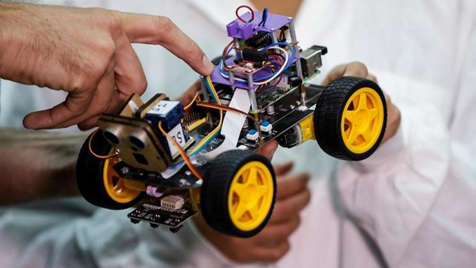
- It could help advance disease diagnosis and improve security checks.
- Locusts have an acute sense of smell, which the researchers have managed to harness into their bio-hybrid robot, making it far more sensitive than existing electronic sniffers.
- On the four-wheeled robot, the researchers placed the insect’s antenna between two electrodes that send electrical signals as a response to a nearby odour.
- Each scent has a unique signature which, with machine learning, the robot’s electronic system can identify.
About Bio-Hybrid Robots:
- Bio-hybrid robots refer to robots that integrate biological components with artificial components, such as electronics and mechanics.
- These robots may use biological materials such as cells, tissues, or muscles as actuators, sensors, or energy sources.
- Advantages: greater dexterity, adaptability, and energy efficiency compared to traditional robotic systems.
https://www.thehindu.com/sci-tech/science/israeli-scientists-develop-sniffing-robot-with-locust-antennae/article66477154.ece
Integrative Medicine (IM) - Edukemy Current Affairs
Why in news? Recently, the Ministry of Health and Family Welfare and the Ministry of Ayush inaugurated Integrative Medicine (IM) Centre at Safdarjung hospital.
About:
- IM is defined as healing-oriented medicine that takes account of the whole person (body, mind, and spirit), including all aspects of lifestyle.
- It emphasizes the therapeutic relationship between practitioner and patient, is informed by evidence, and makes use of all appropriate therapies.
- IM neither rejects conventional medicine nor accepts alternative therapies
- IM is aimed at harnessing the potential of India's rich heritage and medical knowledge, along with using modern advancements in allopathy.
https://www.business-standard.com/article/economy-policy/integrative-medicine-centres-will-start-at-govt-medical-sites-mandaviya-123020701916_1.html
Bio-Fertilizers - Edukemy Current Affairs
Why in news? Recently, The Centre informed the parliament that no proposal is there to make bio-fertilizers compulsory.
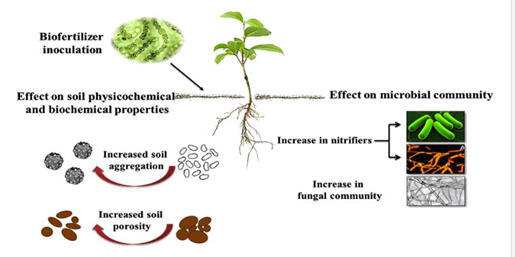
About:
- Biofertilizers are substance that contains microbes, which helps in promoting the growth of plants and trees by increasing the supply of essential nutrients to the plants.
- Biofertilizers are live microbial products that do not contain any nutrients.
- There are 11 bio-fertilizers notified under Fertilizer (Control) Order, 1985
- Rhizobium, Azotobactor, Azospirillum, Phosphate Solubilising Bacteria, Mycorrhizal Bio-fertilisers, Potassium Mobilizing Bio-fertilizers (KMB), Zinc Solubilizing Biofertilizers (ZSB), Acetobactor, Carrier-Based Consortia, Liquid Consortia, and Phosphate Solubilising Fungus.
https://newsonair.com/2023/02/08/parliament-session-no-proposal-to-make-bio-fertilizers-compulsory-pm-kisan-beneficiaries-rose-to-10-45-crore/
International Energy Forum - Edukemy Current Affairs
Why in news? Recently, India hosted 9th Asian Ministerial Energy Roundtable in association with IEF in Bengaluru.

About:
- The IEF is an inter-governmental arrangement set up in 1991 and based (Secretariat) in Riyadh, Saudi Arabia.
- It serves as neutral facilitator of informal, open, informed and continuing global energy dialogue among its member countries.
- IEF is world's largest international organization of energy ministers from 72 countries (including India) and includes both producing and consuming nations.
- The Forum's biennial Ministerial Meetings are the world's largest gathering of Energy Ministers.
- Theme for this roundtable was “Mapping new pathways for energy security, inclusive growth, and energy transitions”.
- Its membership accounts for 90% of the global supply and demand for oil and gas.
https://www.businessworld.in/article/Energy-Transition-Could-Be-Greatest-Leap-In-Global-Economic-Prosperity-Since-1st-Industrial-Revolution-UAE-Min/07-02-2023-464777/
Google Bard - Edukemy Current Affairs
Why in news? Google has finally decided to start public testing for a new AI chatbot of its own called Bard.
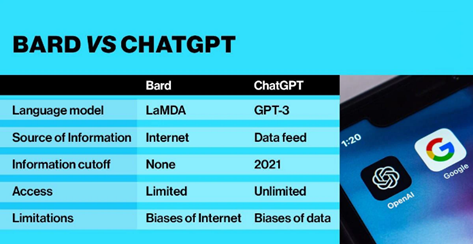
About:
- Bard is based on the Language Model for Dialogue Application (LaMDA), Google’s own conversational AI chatbot. It is termed an “experimental conversational AI service.”
- It will give in-depth, conversational, and essay-style answers just like ChatGPT does right now.
- However, the model is currently a “lightweight” version of LaMDA, and the one being “requires significantly less computing power, enabling it to scale to more users.
- It is built on Transformer technology, which is also the backbone of ChatGPT and other AI bots.
- Transformer technology is a Neural Network Architecture, which is capable of making predictions based on inputs.
https://indianexpress.com/article/explained/explained-sci-tech/bard-google-chatgpt-announcement-explained-8428565/
Jupiter Moon - Edukemy Current Affairs
Why in news? Jupiter, with 92 moons, beats Saturn to become the planet with the most moons.

About:
- Jupiter is home to the first moons discovered in our solar system, which functions like a mini solar system.
- Jupiter's four largest moons are called Galilean satellites: Lo, Europa, Ganymede, and Callisto.
- Lo is the most volcanically active body in the solar system.
- Europa's surface is mostly water ice.
- Ganymede is the largest moon in the solar system and is the only moon known to have its own internally generated magnetic field.
- Callisto's surface is extremely heavily cratered and ancient.
https://www.thehindu.com/sci-tech/science/jupiter-beats-saturn-to-become-the-planet-with-most-moons-92/article66470703.ece
Share the article
Get Latest Updates on Offers, Event dates, and free Mentorship sessions.

Get in touch with our Expert Academic Counsellors 👋
FAQs
UPSC Daily Current Affairs focuses on learning current events on a daily basis. An aspirant needs to study regular and updated information about current events, news, and relevant topics that are important for UPSC aspirants. It covers national and international affairs, government policies, socio-economic issues, science and technology advancements, and more.
UPSC Daily Current Affairs provides aspirants with a concise and comprehensive overview of the latest happenings and developments across various fields. It helps aspirants stay updated with current affairs and provides them with valuable insights and analysis, which are essential for answering questions in the UPSC examinations. It enhances their knowledge, analytical skills, and ability to connect current affairs with the UPSC syllabus.
UPSC Daily Current Affairs covers a wide range of topics, including politics, economics, science and technology, environment, social issues, governance, international relations, and more. It offers news summaries, in-depth analyses, editorials, opinion pieces, and relevant study materials. It also provides practice questions and quizzes to help aspirants test their understanding of current affairs.
Edukemy's UPSC Daily Current Affairs can be accessed through:
- UPSC Daily Current Affairs can be accessed through Current Affairs tab at the top of the Main Page of Edukemy.
- Edukemy Mobile app: The Daily Current Affairs can also be access through Edukemy Mobile App.
- Social media: Follow Edukemy’s official social media accounts or pages that provide UPSC Daily Current Affairs updates, including Facebook, Twitter, or Telegram channels.

